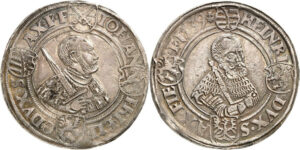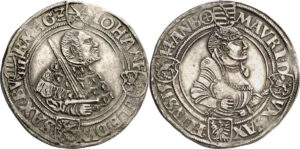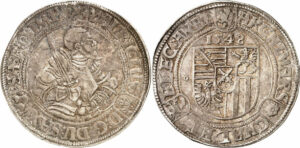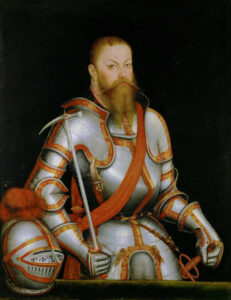The year is 1545. It’s autumn. And each day, as the trees lose more of their leaves, messengers set out on their arduous journey, one after another. Each of them carries a letter from the Elector of Saxony and the Landgrave of Hesse announcing the victory of the Schmalkaldic League over Henry of Brunswick-Wolfenbüttel. Enclosed with each letter is a precious representative coin. One of these coins will be auctioned by the auction house Künker on 20 June 2022 as part of the Dr. Walter Kemlein Collection ‘Saxonia in Nummis’.

The obverse of the piece depicts the three leaders of the Schmalkaldic League. Positioned in the centre is the highest-ranking of them: John Frederick, Elector of Saxony. In the place of honour to his right – or his left, for the observer of the coin – is Philip, Landgrave of Hesse. On the other side is Maurice, the Duke of Saxony. They are all depicted in full armour. And just to avoid any confusion as to who these men are, they are not only holding shields with their coats of arms, but are also labelled with an additional banner.
Above the three figures is a phrase based on Psalm 36:25. The psalm says: I have been young, and now am old, yet I have not seen the righteous forsaken. On the coin, this quotation is shortened, leaving its meaning open: the righteous will not be forsaken or the righteous will not forsake.
On the reverse, an extensive inscription explains the purpose of the representative coin: On 21 October in 1545, Duke Henry of Brunswick and his son Charles were defeated with a great army at Bockenem, captured and taken to Kassel by the Christian leaders of the League, Landgrave Philip of Hesse, in the presence of Duke Maurice of Saxony.
Why, we might wonder, did John Frederick, Elector of Saxony, decide not to be mentioned on the reverse, while Duke Maurice of Saxony features so prominently? To understand the reason for this, we have to take a little look at the politics of the time. But we can tell you one thing: if it had been up to Duke Maurice, he certainly wouldn’t have appeared on this representative coin.

Saxony: A Land Divided
Saxony had not been unified since 1485. The brothers Ernest and Albert had divided their inherited Wettin lands between them. Ernest and his descendants received the territories around Wittenberg, Weimar, Gotha and Coburg, along with the title of elector.
Meanwhile, Albert and his descendants henceforth held ‘only’ the title of duke. Their territory included the Wettin properties around Dresden and Meissen, as well as the wealthy mining towns in the Ore Mountains. Incidentally, the profits generated by the silver mines were divided between the Ernestines and the Albertines, just like the revenues from some other territories and privileges.
Before it was partitioned, Saxony was one of the richest and most powerful dominions in the Holy Roman Empire. And it could have remained one of the richest and most powerful dominions after the partition had its rulers agreed with each other and pursued a common policy. But then came the Reformation. And while the Electorate of Saxony became the motherland of the Reformation, the Duchy of Saxony established itself as a stronghold of Catholicism.
The turning point came in 1539. The Duchy of Saxony fell to Henry, who was given the epithet “the Pious” by Protestant historians because his wife successfully persuaded him to convert to Protestantism.
John Frederick, Elector of Saxony, must have rejoiced when the entire Duchy of Saxony converted to Protestantism in the presence of Luther in 1539. After all, with Duke Henry’s support, he was able to elevate his status within the Holy Roman Empire for a long time. And Elector John Frederick was ambitious. The instrument of his ambition was the Schmalkaldic League, initiated by his father.

The Schmalkaldic League
Now, let’s put the pious legend aside for a moment and take a look at what the Schmalkaldic League was actually fighting for: it was about much more than freedom of religion. It was about the relationship between territorial princes and the empire. Charles V, in fact, used his position as emperor to establish institutions in the empire that would create a common legal framework. These included, for example, his Constitutio Criminalis Carolina or “Gerichtsordnung” (the first body of German criminal law) and his “Münzordnung” (minting ordinance), but also a “Reichsgericht” (Imperial court), before which every subject of a prince could – at least in theory – assert their rights.
So, when some of the imperial estates left the 1530 Imperial Diet of Augsburg in protest, it was by no means just because of Luther. They have been referred to as Protestants ever since. The Schmalkaldic League, founded a year later, served primarily as a form of military defence against possible repression by the imperial institutions, because the confiscation of church property, justified by Luther, violated every imperial law.
The Elector of Saxony was the initiator and highest-ranking member of the Schmalkaldic League. Any increase in the Schmalkaldic League’s status also meant an increase in power. He therefore tried to persuade Duke Henry, who had become a Protestant, and his son to become members of the Schmalkaldic League.

Young Maurice
And that brings us back to the year 1539, when Henry took over the rule of the Duchy of Saxony and protestantised his country. Henry’s eldest son Maurice was 18 years old at the time, and had already led a rather varied life, religiously speaking. He was baptised a Catholic. One of his benefactors had been Cardinal Albert of Brandenburg, who hosted the young Maurice at his court for a year. Maurice had a Catholic upbringing, during which his mother also tried to convert him and his father to the Protestant faith. Maurice was 16 when his father converted. As a subject of his father, Maurice had to do the same. Was Maurice a staunch Protestant? We don’t know. In any case, he lived and died by the Protestant faith.
Between the Schmalkaldic League and the Empire
Now that we’ve spent so long focussing on Saxony, we need to take a look at Hesse, which was ruled by the experienced Landgrave Philip. Maurice knew him personally, since Philip was the son-in-law of the Duke of Saxony, now deceased. But when Philip became a Reformer, he sought an alliance with the Protestant Electorate of Saxony instead.
Even then, politics was determined by personal interests. In 1539, Landgrave Philip was diagnosed with syphilis. He responded by attempting to legalise his relationship with his mistress through marriage. The logic behind this idea is barely comprehensible to the modern mind. It was unusual even then, since it was considered bigamy under Catholic and imperial law. For that reason, Landgrave Philip appointed a committee of Wittenberg theologians, who confirmed to him that it was permissible under divine law to enter into a second marriage. This statement, signed by Luther and Melanchthon among others, damaged the reputations of the reformers greatly at the time.
As a second step, Landgrave Philip negotiated with Emperor Charles V to obtain impunity for himself, since bigamy was punishable by death under the new imperial law. During this time, Maurice was staying at the Landgrave’s court. It seems that he felt drawn to the much older Landgrave of Hesse. For example, he decided, without obtaining his parents’ permission, to marry the latter’s daughter Agnes, who was struggling to find any other suitable match due to her father’s bigamy.
Maurice was still at the Landgrave’s court when the news of his father’s death arrived on 18 August 1541. And when Landgrave Philip pledged to Emperor Charles V not to ally himself to any powers that were hostile to the latter, Maurice also acceded to this treaty before leaving for his Duchy of Saxony with some of his father-in-law’s advisers and his young wife.

An Independent Policy
Maurice therefore felt tied to both parties right from the start: his father-in-law, Landgrave Philip, and his emperor. However, he refused to become a full member of the Schmalkaldic League.
On the contrary, Maurice clearly asserted his rights vis-à-vis John Frederick, Elector of Saxony: when the Elector attempted to occupy a territory he controlled jointly with Maurice in the Wurzener Feud of 1542, the latter was ready to start a war, which was only prevented by the intervention of Landgrave Philip.

The War Against Henry the Younger
And now, we must leave Saxony once again and head to Brunswick, where the staunchly Catholic Henry the Younger was attempting to expand his Principality of Brunswick-Wolfenbüttel. His lawyers certainly had some very good reasons for his conquest of Goslar. But Goslar was a member of the Schmalkaldic League, and so the defence alliance was invoked. The combined armies of Elector John Frederick and Landgrave Philip drove out Henry the Younger in 1542. Maurice contributed subsidies of 50,000 talers to this campaign, though rather hesitantly. He didn’t want to strain his good relationship with the Emperor, but he also wanted to please his father-in-law.
Tricked!
Not even two years later – Maurice was fighting the French in the service of the Emperor – he received a new request for help from Hesse: Henry of Brunswick-Wolfenbüttel was preparing for war. Philip was hoping for Maurice’s support. Maurice was willing to help, but only on the express condition that Hessian territory was occupied. He would not support any military advance by the Schmalkaldic League.
When the armies of Hesse and the Electorate of Saxony gathered close to the free imperial city of Mühlhausen, there came yet another call for help, at which point Maurice deployed his troops. He informed the Emperor that he was not supporting the Schmalkaldic League, but simply fulfilling the terms of his treaty with Landgrave Philip.
It wasn’t until Maurice arrived that he realised Hesse had never been in danger. There he was, standing in between the fronts. At first, he hoped to broker a peace. That failed. Maurice was forced into action. And so it was that his troops were present when the victory over Henry of Brunswick-Wolfenbüttel was won.
For Maurice and his political objectives, this victory was a disaster. The reputation he had so painstakingly built up was in danger of slipping away. The capture of Henry of Brunswick-Wolfenbüttel was unlawful. Maurice promised his noble prisoner that he would be spared imprisonment. But this was a promise that he had to break, since Landgrave Philip refused to enter into any negotiations.
Maurice therefore had no reason to draw any more attention to his involvement in the capture of Henry of Brunswick-Wolfenbüttel by commemorating it on a coin. Quite the contrary. John Frederick, Elector of Saxony, and Landgrave Philip tried to force him into joining the Schmalkaldic League by minting this coin and thus publicising the fact that he had broken imperial law on their side.

Elector
Maurice refused to do so. He was not the ‘Judas of Meissen’, as he was insultingly dubbed in Protestant propaganda. He remained true to his emperor and travelled to the Imperial Diet in Regensburg in person to assure Charles V of his loyalty. Charles put him to the test: specifically, he entrusted him with the enforcement of the imperial sentence imposed on Elector John Frederick I on 19 July 1546 – because of the attacks on Brunswick-Wolfenbüttel and the capture of Henry the Younger.
Duke Maurice of Saxony supported the Emperor in the Schmalkaldic War and thereby won the electorship for the Albertines, which was taken away from the Ernestines.
The fact that, in the years that followed, the Emperor disappointed Maurice so badly that he ended up relinquishing his loyalty and becoming one of his most dangerous opponents is another story. But let’s just say that it was Maurice who managed to negotiate a compromise with King Ferdinand I that would allow any future Protestant prince to be both Protestant and loyal to the emperor. Maurice’s compromise, the Peace of Passau, became the basis for the 1555 Peace of Augsburg treaty.
Here you can browse the online catalogue of Künker’s Summer Auction Sales.




